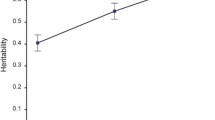Abstract
This study examined the contributions of genetic and environmental factors to the observed correlation between intelligence test scores and speed of information processing, based on data for same-sex adult twin pairs (age, 15–57). Verbal and performance IQ scores from the Multidimensional Abilities Battery, as well as 11 reaction-time measures derived from a battery of information-processing tasks, were available for 50 monozygotic and 32 dizygotic pairs of twins. Multivariate biometrical analyses were used to estimate genetic and environmental parameters underlying observed variances and covariances among intelligence test scores and a general speed of information-processing factor (based on a linear composite of the 11 reaction-time scores). A common-factor model with loadings on general speed of processing, verbal IQ, and performance IQ fit the data well. The common factor was influenced primarily by additive genetic effects, such that the observed relationships among the speed and IQ measures are mediated entirely by hereditary factors. There was additional specific genetic variance for Verbal IQ and specific shared-twin environmental variance for Performance IQ. However, twin similarity for general speed of processing was explained entirely by genetic factors related to intelligence. The results emphasize the importance of common, heritable, biological mechanisms underlying the speed-IQ association.
Similar content being viewed by others
References
Barrett, P., Eysenck, H. J., and Lucking, S. (1986). Reaction time and intelligence: A replicated study.Intelligence 10:9–40.
Bouchard, T. J., Jr., and McGue, M. (1981). Familial studies of intelligence: A review.Science 212:1055–1059.
Deary, I. J., and Caryl, P. G. (1991). Intelligence, EEG and evoked potentials. In Vernon, P. A. (ed.),Biological Approaches to the Study of Human Intelligence, Ablex, Norwood, NJ.
Donchin, E., and Lindsley, D. B. (1966). Average evoked potentials and reaction times to visual stimuli.Electroenceph. Clin. Neurophysiol. 20:217–223.
Dustman, R. E. (1965). Phase of alpha brain waves, reaction time, and visually evoked potentials.Electroenceph. Clin. Neurophysiol 18:433–440.
Eaves, L. J., Heath, A. C., and Martin, N. G. (1984). A note on the generalized effects of assortative mating.Behav. Genet. 14:371–376.
Ertl, J. P., and Schafer, E. W. P. (1969). Brain response correlates of psychometric intelligence.Nature 223:421–422.
Falconer, D. (1989).Introduction to Quantitative Genetics, Longman Scientific & Technical, London.
Fulker, D. W., Baker, L. A., and Bock, R. D. (1984). Estimating components of covariation using LISREL.Data Anal. 1(3):5–8.
Heath, A. C., Neal, M. C., Hewitt, J. K., Eaves, L. J., and Fulker, D. W. (1989). Testing structural equation models for twin data using LISREL.Behav. Genet. 19:9–36.
Hendrickson, D. E. (1982). The biological basis of intelligence. II. Measurement. In Eysenck, H. J. (ed.),A Model of Intelligence, Springer-Verlag, Berlin.
Ho, H.-Z., Baker, L. A., and Decker, S. N. (1988). Covariation between intelligence and speed of cognitive processing: Genetic and environmental influences.Behav. Genet. 18:247–261.
Jackson, D. N. (1984).Multidimensional Aptitude Battery Manual, Research Psychologists Press, Port Huron, MI.
Joreskog, K. G., and Sorbom, D. (1986).LISREL VI: Analysis of Linear Structural Relationships by Maximum Likelihood, Instrumental Variables, and Least Squares Methods, Scientific Software, Mooresville, IN.
Martin, N. G., and Eaves, L. J. (1977). The genetical analysis of covariance structure. Heredity138:79–95.
McArdle, J. J., and Goldsmith, H. H. (1990). Alternative common-factor models for multivariate biometric analyses.Behav. Genet. 20:569–608.
McArdle, J. J., Connell, and Goldsmith, H. H. (1980). Structural modeling of stability and genetic influence: Some results from a longitudinal study of behavioral style.Behav. Genet. 10:487 (abstr.).
McGue, M., Bouchard, T. J., Jr., Lykken, D. T., and Feuer, D. (1984). Information processing abilities in twins reared apart.Intelligence 8:239–258.
Morrell, L. K., and Morrell, F. (1966). Evoked potentials and reaction times: A study of intra-individual variability.Electroenceph. Clin. Neurophysiol. 20:567–575.
Nettlebeck, T., and Kirby, N. H. (1983). Measures of timed performance and intelligence.Intelligence 7:39–52.
Nichols, R. C., and Bilbrow, W. C., Jr., (1966). The diagnosis of twin zygosity.Acta Genet. Med. Gemellol. 16:265–275.
Plomin, R., and DeFries, J. C. (1980).Behavioral Genetics: A Primer, W. H. Freeman, New York.
Vernon, P. A. (1983). Speed of information processing and general intelligence.Intelligence 7:53–70.
Vernon, P. A. (1985). Individual differences in general cognitive ability. In Hartlage, C. L., and Telzrow, C. F. (eds.),The Neuropsychology of Individual Differences: A Developmental Perspective, Plenum Press, New York.
Vernon, P. A. (ed.) (1987).Speed of Information-Processing and Intelligence, Ablex, Norwood, NJ.
Vernon, P. A. (1989). The heritability of measures of speed of information-processing.Personal. Individ. Diff. 10:573–576.
Vernon, P. A., and Jensen, A. R. (1984). Individual and group differences in intelligence and speed of information processing.Personal. Individ. Diff. 5(4):411–423.
Vernon, P. A., and Kantor, L. (1986). Reaction time correlations with intelligence test scores obtained under either timed or untimed conditions.Intelligence 10:315–330.
Vernon, P. A., and Mori, M. (1989a). Intelligence, reaction times, and nerve conduction velocity.Behav. Genet. 19:779 (abstr.).
Vernon, P. A., and Mori, M. (1989b). Nerve conduction velocity: A physiological correlate of intelligence and speed of information-processing. Paper presented at the annual meeting of the International Society for the Study of Individual Differences, Heidelberg, West Germany.
Vernon, P. A., Nador, S., and Kantor, L. (1985). Reaction times and speed-of-processing: Their relationship to timed and untimed measures of intelligence.Intelligence,9:357–374.
Weschler, D. (1981).Weschler Adult Intelligence Scale-Revised, Psychological Corp., Cleveland, OH.
Author information
Authors and Affiliations
Additional information
This research was supported by funding from the Pioneer Fund, Inc.
Rights and permissions
About this article
Cite this article
Baker, L.A., Vernon, P.A. & Ho, HZ. The genetic correlation between intelligence and speed of information processing. Behav Genet 21, 351–367 (1991). https://doi.org/10.1007/BF01065972
Received:
Accepted:
Issue Date:
DOI: https://doi.org/10.1007/BF01065972




